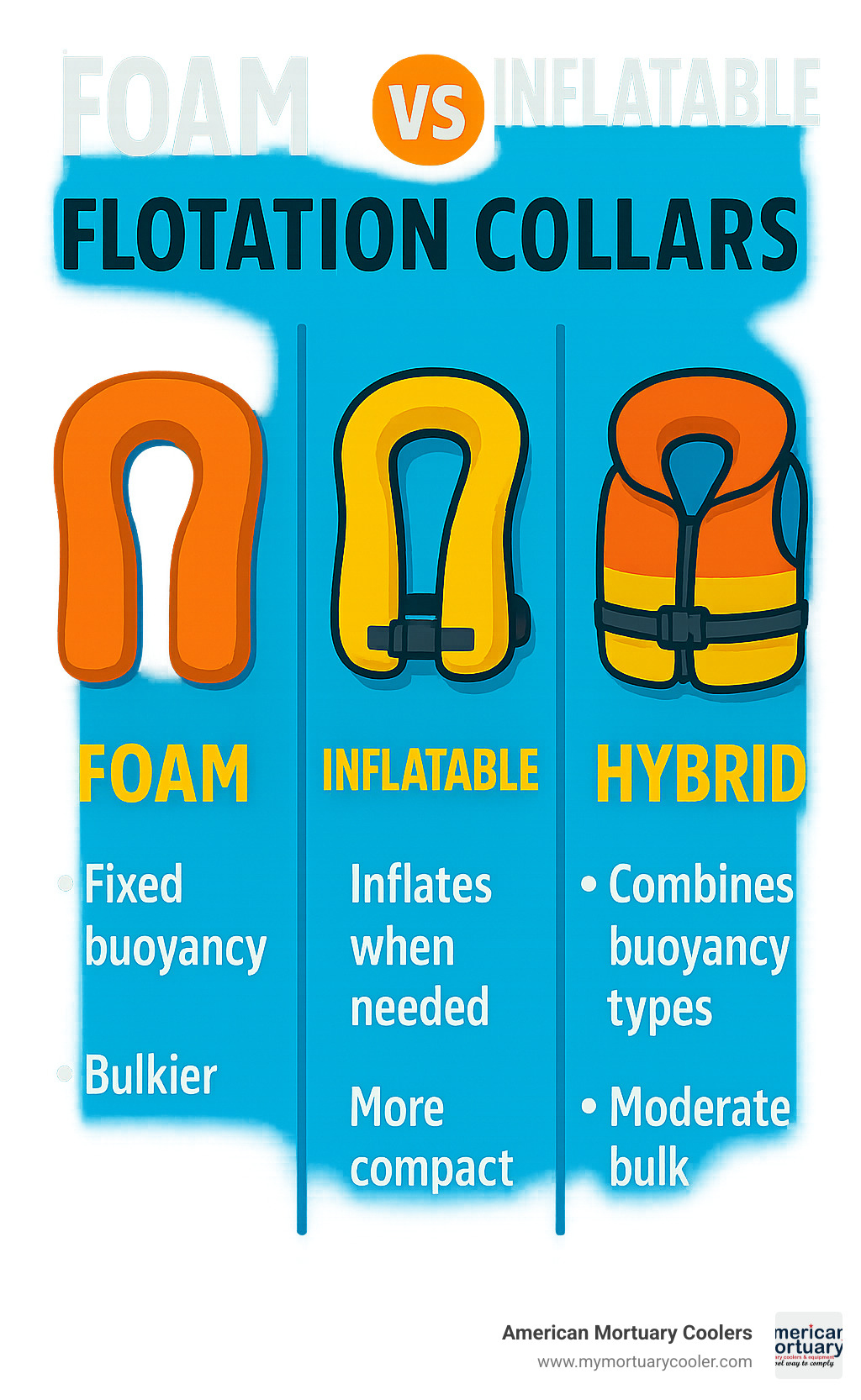Staying Afloat: Essential Guide to Flotation Collars
A flotation collar is a buoyancy device designed to keep people, pets, equipment, or vessels stable and afloat in water. These versatile safety tools come in various forms depending on their specific application.
Types of Flotation Collars:
- Rescue Collars: Attach to basket stretchers for water rescue (30kg buoyancy)
- Marine Collars: Provide stability for boats and RIBs (foam or hybrid construction)
- Pet Safety Collars: Prevent pet drowning (available in 11 sizes)
- PWC/Jet Ski Collars: Add stability to personal watercraft (1950mm length)
- Industrial Hawser Collars: Keep mooring lines visible and afloat (15kg/m buoyancy)
- Infant Therapy Rings: Support babies during water activities ($45-50 price range)
Flotation collars work by trapping air or using buoyant materials like closed-cell foam to create upward force in water. Most designs feature durable outer shells made from PVC, polyurethane, or polyester that protect the buoyant core material.
I'm Mortuary Cooler, a national supplier of specialized equipment with extensive experience evaluating flotation collar systems for various applications including emergency response scenarios. My background in safety equipment has given me unique insights into how flotation collars provide critical support in water-based operations.
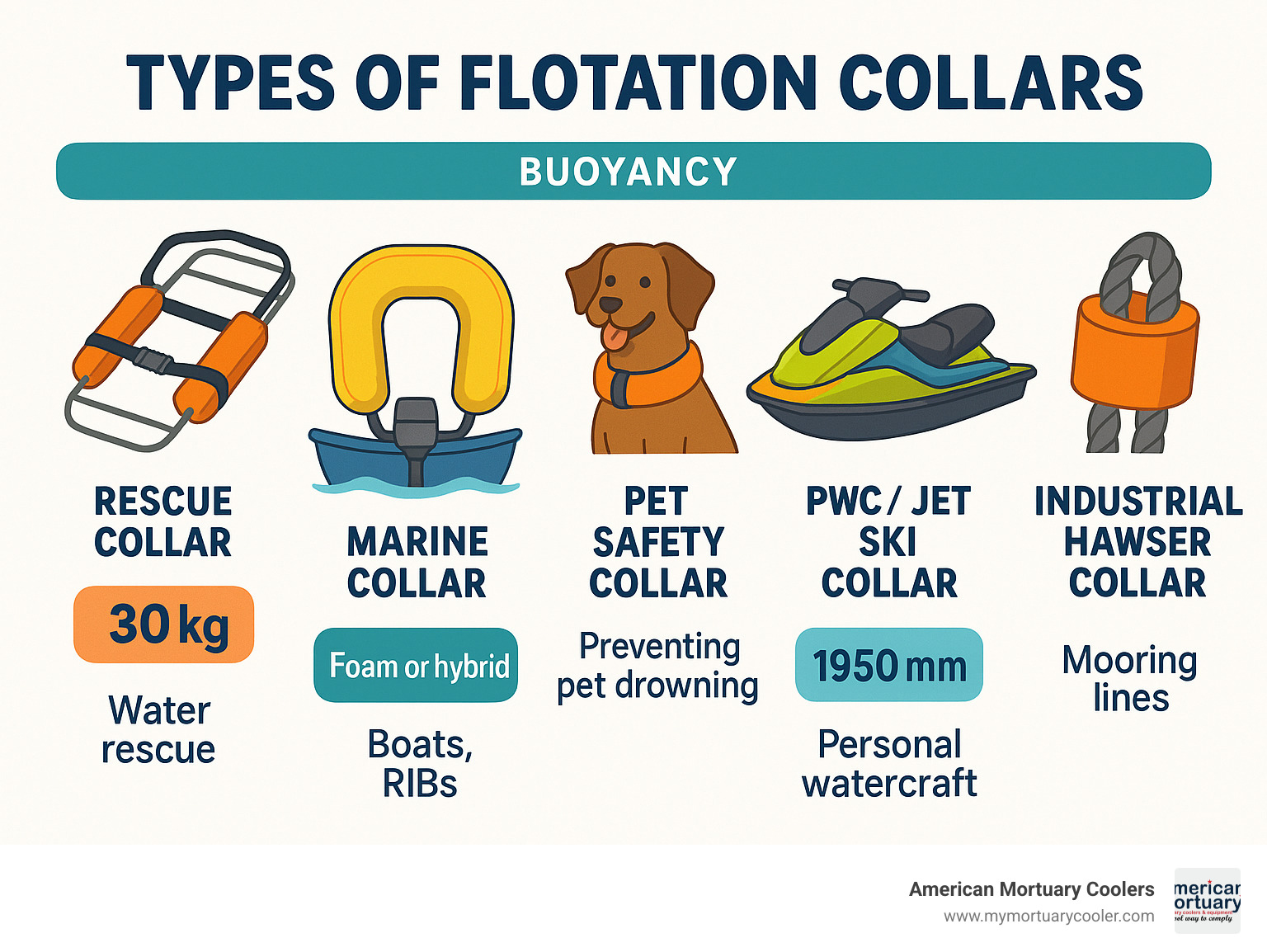
Understanding the Flotation Collar: Functions and Benefits
When I first encountered a flotation collar, I was amazed at how such a simple concept could be so versatile. It's far more than just a ring of foam—it's a critical safety device that saves lives and provides peace of mind around water.
A flotation collar works by creating buoyancy where you need it most. Whether supporting a rescue stretcher during a swift-water emergency or stabilizing your boat during rough weather, these collars provide that extra margin of safety we all hope we'll never need—but are grateful to have when we do.
The primary functions of a good flotation collar include providing reliable buoyancy support to keep people, pets, or equipment afloat; improving stability by reducing dangerous rolling or tipping; enabling safer rescue operations in water emergencies; and even supporting therapeutic applications for patients in rehabilitation settings.
I've spoken with rescue teams across the Midwest who swear by their stretcher flotation collars, marina operators in the Southeast who recommend them for every vessel, and countless pet owners in Texas who've seen these devices prevent tragedy during family lake outings.
Why Every Water-Goer Should Know the Term "flotation collar"
The statistics around water accidents are sobering. The CDC reports over 3,500 unintentional drownings annually in the United States—approximately ten precious lives lost every day. What's most heartbreaking is that many of these tragedies could be prevented with proper safety equipment.
Without flotation assistance, both humans and pets can succumb to drowning in as little as 15 to 20 minutes. A flotation collar provides that critical buffer of time and safety during emergencies.
I've seen these versatile devices used effectively in swift-water rescues during flash floods, as stability aids for recreational boaters, as safety equipment for jet ski enthusiasts, and even as support devices in therapy pools. They're truly the unsung heroes of water safety.
As one veteran rescue instructor told me, "A flotation collar isn't just gear—it's your backup when everything else goes wrong." That perspective has always stuck with me.
Historic Lifesaver: The Apollo 11 Flotation Collar
Perhaps the most famous flotation collar in history made its debut on July 24, 1969. As the Apollo 11 command module splashed down in the Pacific Ocean, Navy divers leapt from helicopters into the rolling sea with a crucial mission: secure a custom-designed inflatable collar around the spacecraft.
This specialized collar did exactly what modern versions still do today—it provided stability and prevented capsizing while the astronauts awaited retrieval. Without it, one of humanity's greatest achievements might have ended in tragedy just moments from success.
Today, that historic flotation collar is proudly displayed at the Smithsonian, a testament to how these seemingly simple devices play critical roles in complex operations.
"Navy swimmers literally dove into history by installing this collar in choppy Pacific waters."
— Museum Curator, Smithsonian
The engineering principles behind that famous collar continue to inspire modern innovations. You can learn more about contemporary applications in specialized fields here: Single Trip Deployment of Multistage Completion Liners Through the Use of Interventionless Flotation Collars.
At American Mortuary Coolers, we appreciate the importance of reliable equipment in critical situations. While our specialty is different, we share that commitment to providing dependable solutions when they matter most.
How Does a Flotation Collar Work?
Ever wonder what keeps those rescue stretchers bobbing safely in rough waters? It all comes down to good old Archimedes and his famous principle. When a flotation collar is placed in water, it pushes water out of the way (displaces it), and that water pushes back with an upward force. If this upward force exceeds the collar's weight, voilà – it floats! And more importantly, it keeps whatever it's attached to floating too.
Think of flotation collars as water wings for grown-up equipment. They come in three main varieties, each with its own personality:
Closed-cell foam collars are the reliable workhorses. Made from materials like polyethylene or polyurethane foam, they're practically unsinkable because the foam contains thousands of tiny sealed air pockets. Even if you puncture the outer covering, these tough guys keep floating. That's why they're so popular for rescue operations where failure isn't an option.
Inflatable collars are the space-savers. When deflated, they tuck away neatly until needed, then spring to life with a few breaths or the pull of a CO2 cartridge. The Apollo 11 spacecraft used this type – not something you'd want to trust to foam that might get waterlogged!
Hybrid designs give you the best of both worlds – combining foam cores with inflatable chambers. They're like having insurance on your insurance, offering reliable buoyancy with adjustable performance.
What makes these devices so effective isn't just their buoyant materials, but also their clever design. Surface tension helps them hug the object they're protecting, while their shapes are carefully engineered for specific uses – curved to wrap around boat hulls or contoured to fit comfortably around a dog's neck.
Anatomy of a Modern "flotation collar"
Cut open a flotation collar and you'll find it's more sophisticated than it looks:
The outer shell is like a suit of armor – typically made from rugged PVC, polyurethane, or polyester fabric. This tough exterior stands up to scrapes, sun damage, and even chemical exposure, protecting the buoyant goodies inside.
At its heart, the core material does the heavy lifting. This might be strips of closed-cell foam that trap air, inflatable bladders filled with air, or some clever combination of both.
Attachment points are the unsung heroes that keep everything secure. Depending on the application, you might find sturdy straps, quick-release Velcro, metal D-rings, or custom fittings designed for specific equipment.
For inflatable and hybrid models, valves are the gateway to buoyancy – allowing for inflation when needed and controlled deflation for storage.
| Type | Core Material | Key Uses | Pros | Cons |
|---|---|---|---|---|
| Foam | Polyethylene/PU | Rescue, marine, industrial | Unsinkable, rugged | Bulkier, less storable |
| Inflatable | Air Bladder | Spacecraft, medical rehab | Compact, lightweight | Needs inflation, puncture risk |
| Hybrid | Foam + Air | High-performance marine | Tunable stiffness | More complex, pricier |
The beauty of modern flotation collars is their versatility. Whether you're securing a rescue stretcher in a rushing river or adding stability to your boat in choppy waters, there's a design engineered specifically for your needs – each one changing Archimedes' ancient principle into a modern lifesaver.
Key Features to Compare Before You Buy
Shopping for a flotation collar doesn't have to be overwhelming. Think of it like buying a life insurance policy – you want the right coverage for your specific needs. Here's what to look for when browsing options:
The buoyancy rating tells you exactly how much lifting power your collar provides. This is measured in kilograms or pounds of upward force. For perspective, Sure Line's rescue collars offer a robust 30 kg of buoyancy, while industrial Floatex hawser collars provide 15 kg per meter – plenty to keep heavy mooring lines visible above water.
Size and fit matter tremendously. A collar that's too small won't provide adequate support, while one that's too large might shift or create drag. Jet Ski enthusiasts, for instance, can choose from Medium to Extra Large collars depending on their watercraft size and intended use.
The materials determine how long your investment will last. Look for UV-stabilized PVC that won't crack in the sunshine, flame-resistant polyester for industrial applications, or marine-grade polyurethane that stands up to salt, sun, and rough handling. Quality materials might cost more upfront but save money over time.
How does it attach to what you're trying to float? The best design depends on your needs – quick-release Velcro for emergency rescue situations, lace-on sleeves for permanent industrial applications, or dedicated D-rings for secure mounting on vessels. The easier it is to attach correctly, the more likely it will be used properly when needed.
For professional or commercial use, certifications provide peace of mind. Look for SOLAS (Safety of Life at Sea) approval, ISO 12402 compliance, or CE marks that indicate the product meets rigorous safety standards.
Finally, consider application-specific features that make a real difference in your situation. Rescue teams need cushioned lift points for patient comfort, parents should insist on dual safety locks for infant neck rings, and industrial users benefit from extra abrasion protection in high-wear areas.
For more guidance on selecting safety equipment that meets your specific needs, check out our comprehensive guide: More info about x services
Rescue Stretchers & Basket Collars
When lives are on the line during water rescues, a flotation collar transforms an ordinary basket stretcher into a life-saving vessel. These specialized collars aren't just accessories—they're essential equipment that keep both the patient and stretcher buoyant during swift-water and flood rescues.
Picture this: emergency responders navigating churning floodwaters while keeping a patient secure and afloat. The right flotation collar makes this possible by providing crucial stability that prevents the stretcher from rolling or submerging—even in rough conditions.
We've seen two main designs dominating the rescue market today:
The 2-piece model offers impressive performance at 130 cm × 20 cm, weighing just 1.4 kg while providing a substantial 30 kg of buoyancy. This design prioritizes quick deployment and maximum flotation.
The 5-piece model maintains the same dimensions (130 cm × 20 cm) but weighs slightly more at 3 kg and provides 20 kg of buoyancy. The multi-piece design offers more configuration options for different rescue scenarios.
Perhaps most importantly, these collars build confidence—both for the rescuers who need to work efficiently and for patients who are already experiencing trauma. That psychological comfort shouldn't be underestimated during emergency situations.
Top Pick: Sure Line 2-Piece Rescue Collar
After reviewing numerous options, the Sure Line 2-Piece Rescue Collar stands out as our top recommendation for rescue teams. What makes it special? Its innovative Velcro attachment system allows for rapid deployment when seconds count, while its impressive 30 kg buoyancy rating ensures the stretcher stays afloat even with a full-sized adult patient.
This model has earned its reputation through successful deployments worldwide. Its universal design fits most standard basket stretcher heads, creating a secure flotation system that cradles the patient's upper body—exactly where that extra buoyancy matters most.
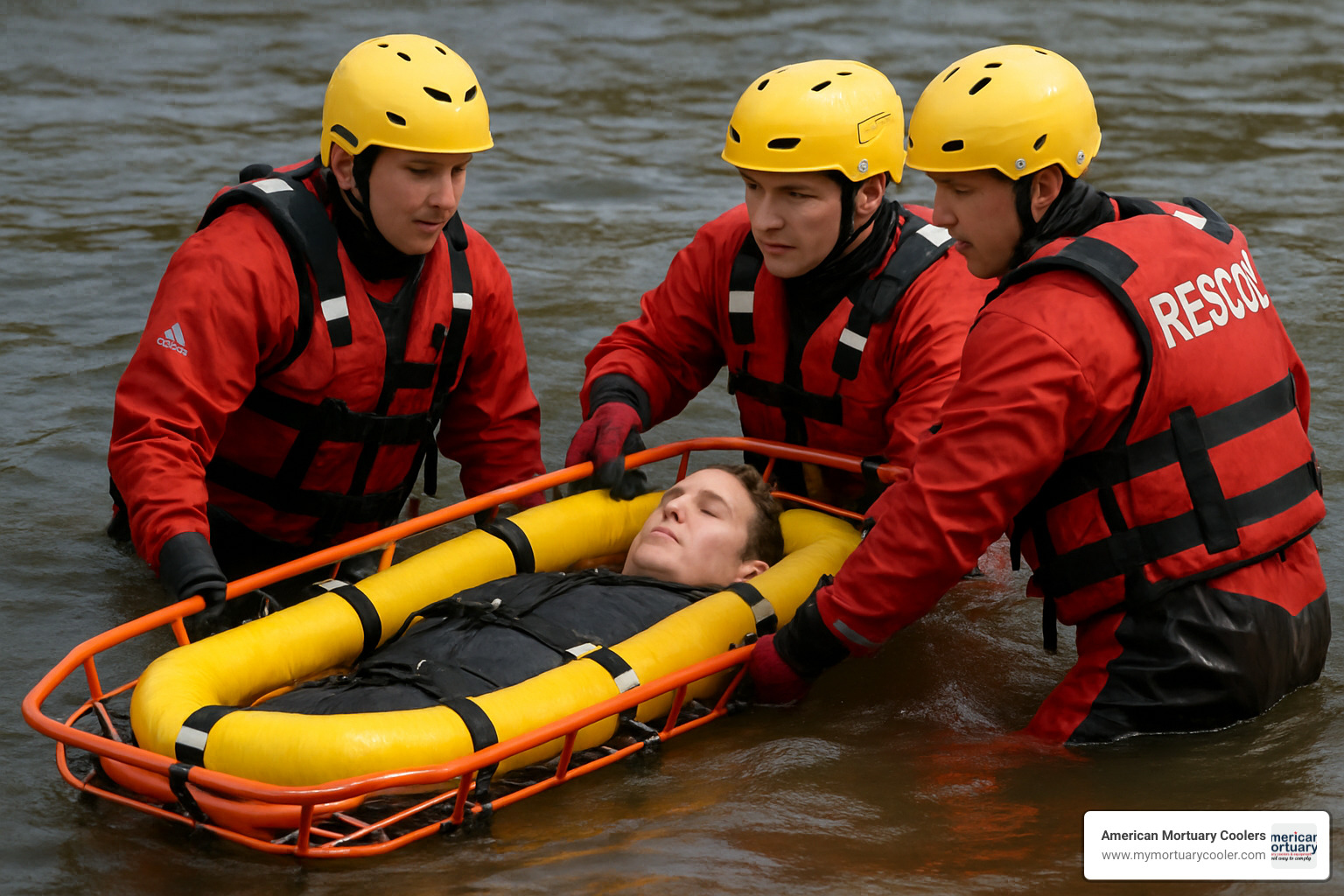
Marine & RIB Collars
When it comes to Rigid Inflatable Boats (RIBs) and high-performance watercraft, flotation collars are not just accessories—they're essential safety and performance components. These specialized collars serve dual purposes: providing crucial buoyancy and acting as protective buffers during docking or unexpected collisions.
What makes these marine collars special is their construction. Most are crafted from polyurethane or PVC-covered foam specifically engineered to withstand harsh marine environments. They're built to handle everything from saltwater exposure to intense UV radiation without degrading or losing buoyancy.
The boating industry has seen remarkable innovation in this space, particularly with FAST collars. These systems have transformed how we think about RIB safety and performance. Unlike traditional air-filled tubes that can puncture, FAST collars use solid foam construction that simply cannot sink—giving boaters peace of mind in even the most challenging conditions.
Boat owners particularly appreciate how these collars absorb impact energy during docking, protecting both the vessel and nearby structures. For commercial operators and rescue teams, this durability translates to lower maintenance costs and extended vessel life.
Top Pick: FAST Polyurethane Collar System
The FAST Polyurethane Collar System stands out as our top recommendation for serious boaters. What makes these collars exceptional is their 100% closed-cell foam construction—creating a truly unsinkable system that requires virtually no maintenance.
Unlike inflatable collars that demand regular pressure checks and occasional repairs, FAST collars deliver worry-free performance season after season. They're custom-fitted to each vessel, ensuring perfect integration with your boat's design while maintaining optimal performance characteristics.
These lightweight yet robust collars have earned their reputation among both recreational boaters and professional rescue fleets. Many commercial operators report significant cost savings over time, despite the higher initial investment, thanks to the virtually maintenance-free design and exceptional longevity.
For existing boat owners, FAST offers retrofit options that can transform your current vessel with their advanced collar technology—no need to purchase an entirely new boat to gain these safety benefits.
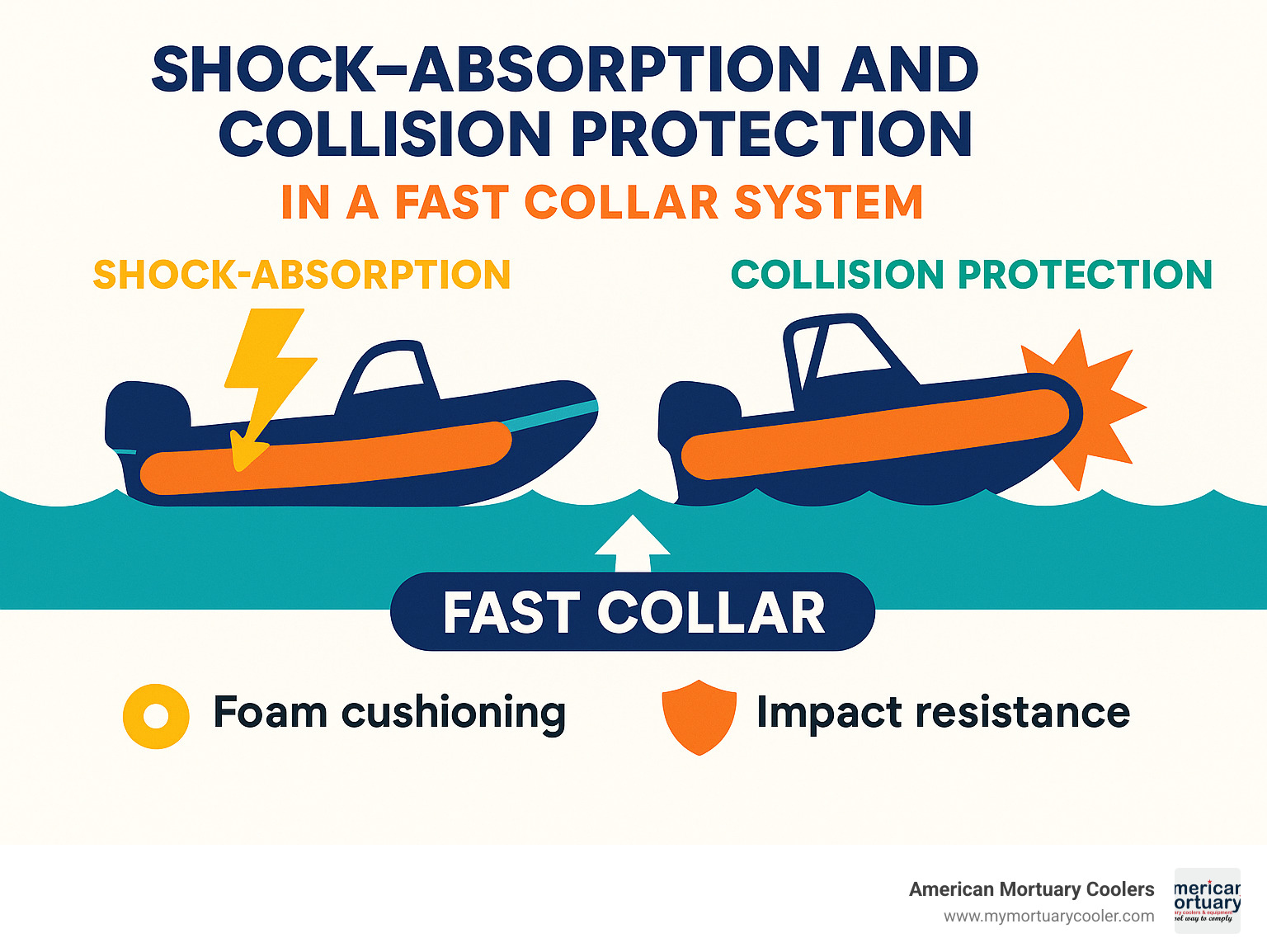
Jet Ski / PWC Collars
There's nothing quite like the thrill of zipping across the water on a jet ski—until an unexpected wave tips you over. That's where flotation collars come in, changing your personal watercraft from "fun but tippy" to "rock-solid stable," especially when you're loaded with fishing gear or navigating choppy waters.
These ingenious stability improvers wrap around your PWC's hull, providing that extra bit of buoyancy right where you need it. Made from closed-cell foam with a tough polyurea skin, they stand up to the harsh realities of saltwater, sun, and the occasional dock bump. Many models feature EVA non-slip decking on top, giving you secure footing when boarding from the water—a small detail that makes a big difference when you're tired after hours of fishing.
Whether you ride a compact Sea-Doo or a larger Yamaha, there's likely a collar that fits, with sizes ranging from Medium to Extra-Large (some extending to an impressive 1950mm in length). The best part? Jet ski enthusiasts from Texas to Australia report that these collars don't slow you down. Thanks to clever design, once you're up on plane, the collar sits above the waterline, maintaining your top speed while providing stability at rest.
Top Pick: XL PWC Collar for Offshore Anglers
For serious offshore enthusiasts, the Jet Ski Fishing Mob - Jet Ski Anti-roll Flotation Collar in XL size stands out as the gold standard. These robust collars feature a generous 1950mm length, perfect for larger PWCs used in offshore fishing and diving trips.
What makes these collars particularly appealing is their DIY-friendly installation. You won't need special tools or professional help—just follow the included instructions, and you'll be up and running in no time. The durable polyurea skin protects the foam core from the elements, ensuring years of reliable service even in harsh marine environments.
These collars have earned their reputation the hard way, with countless successful installations from the Gulf Coast to Melbourne's rough waters. When your day involves hauling fishing gear, coolers, and maybe even a diving tank, this extra stability isn't just a luxury—it's essential safety equipment.
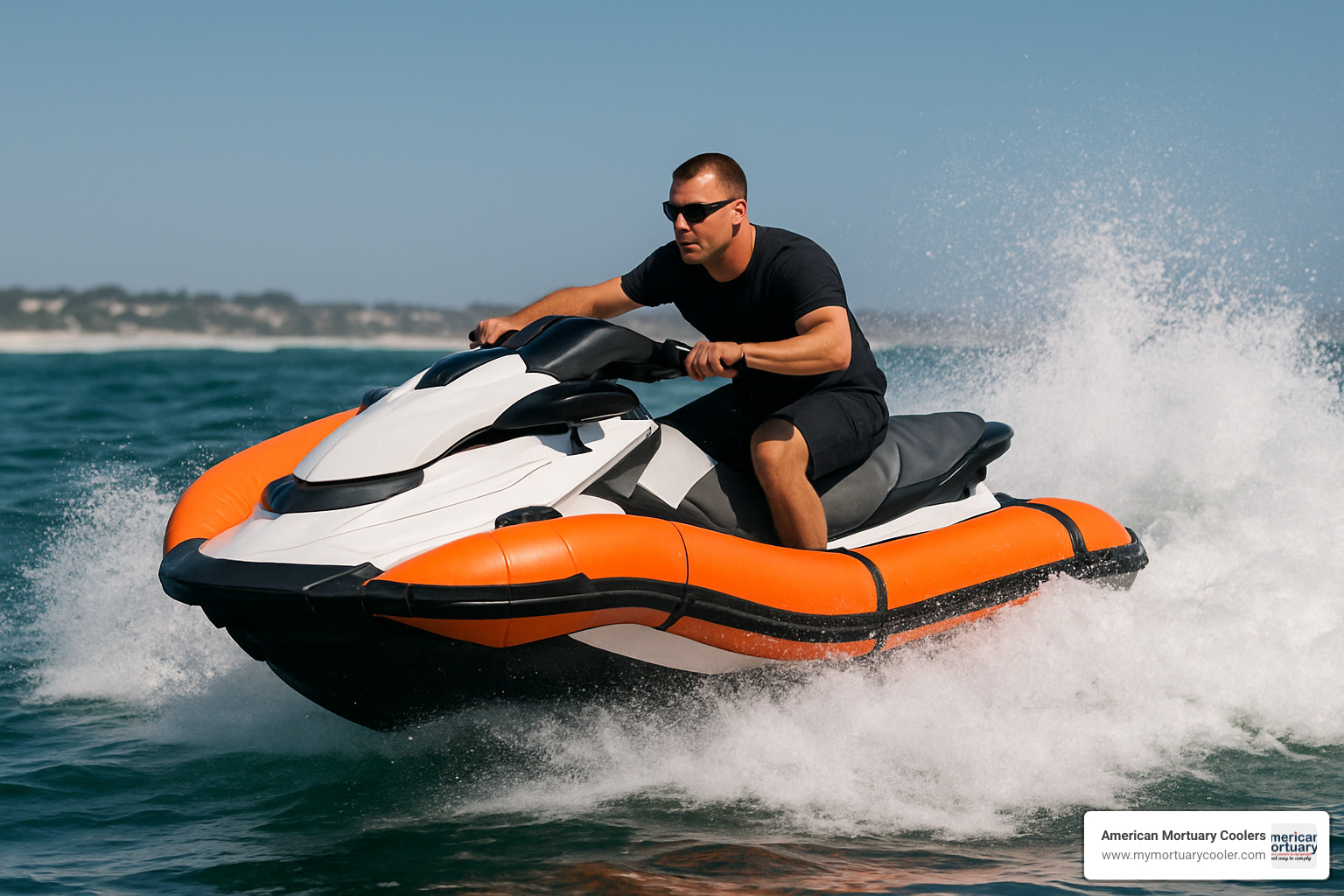
Industrial Hawser & Offshore Collars
When massive ships dock at busy ports, those thick mooring lines (hawsers) need to stay visible and afloat for safety reasons. That's where industrial flotation collars come into play – these unsung heroes of maritime operations prevent accidents and keep propellers from getting tangled in sunken lines.
These specialized flotation collars feature clever lace-on designs that make them easy to attach and remove even in challenging conditions. Most are constructed from durable polyester cloth combined with flame-resistant PVC – materials specifically chosen to withstand the harsh realities of saltwater, constant UV exposure, and the rough handling typical in port operations.
Inside these tough exterior sleeves, you'll find polyethylene foam strips that deliver impressive buoyancy – typically at least 15 kg per meter of collar. What's particularly helpful for busy shipping operations is that these collars can be ordered in custom lengths and buoyancy ratings to match specific vessel needs.
"We've seen a dramatic reduction in line-related incidents since implementing flotation collars on all our mooring hawsers," notes one port operations manager from the Gulf Coast. "They're a simple solution that makes a big difference in visibility and safety."
Top Pick: Floatex Grommet Hawser Collar
The Floatex Hawser Flotation Collar has earned its reputation as the go-to solution for professional maritime operations. These collars feature reinforced grommets that make them exceptionally secure even during rough weather and high-tension mooring situations.
What makes the Floatex model stand out is its combination of polyester cloth exterior and strategically placed PE strips that maintain buoyancy without creating unnecessary bulk. From oil tankers in Louisiana to container ships in international ports, these rugged, customizable sleeves keep operations running smoothly and safely.
Port safety inspectors particularly appreciate how these collars maintain their bright coloration over time, ensuring mooring lines remain visible to vessel operators even in poor lighting conditions or rough seas. For industrial marine operations where reliability isn't optional, these collars represent the gold standard in hawser management.
Pet Flotation Collars
If you've ever watched your furry friend splash around in water, you know that even strong swimming dogs can get into trouble. Veterinarians warn that pets can drown in as little as 15-20 minutes if they become fatigued or panicked in water. That's why flotation collars designed specifically for pets have become essential safety gear for responsible pet owners.
Unlike human life jackets, pet flotation collars focus on keeping your pet's head above water – the most critical factor in preventing drowning. These clever devices wrap comfortably around your pet's neck, providing crucial buoyancy without restricting movement.
What makes a quality pet flotation collar stand out? First, proper sizing is crucial – that's why the best brands offer up to 11 different size options to ensure a secure, comfortable fit for everything from tiny Chihuahuas to massive Newfoundlands. Look for collars with dedicated attachment systems that won't slip off during vigorous swimming or play.
Visibility is another key factor – bright colors help you spot your pet easily, even in choppy water or low light conditions. And since we're talking about pets, durability matters too. The best flotation collars use chew-resistant materials that stand up to teeth and claws while maintaining their buoyancy properties.
Top Pick: WaterWay Babies & HedzUp Pet Collar
The HedzUp dog flotation device has earned enthusiastic support from veterinarians and pet owners alike. What sets this collar apart is its focus on that critical 15-20 minute survival window – providing enough time for pets to find an exit or for owners to reach them.
Many owners report that these collars have given them newfound peace of mind during lake trips and pool parties. Rather than constantly hovering, they can relax a bit knowing their pet has an additional safety measure. The collar serves as both a preventative measure and an "exit aid" – helping tired or confused pets keep their heads above water while finding their way to safety.
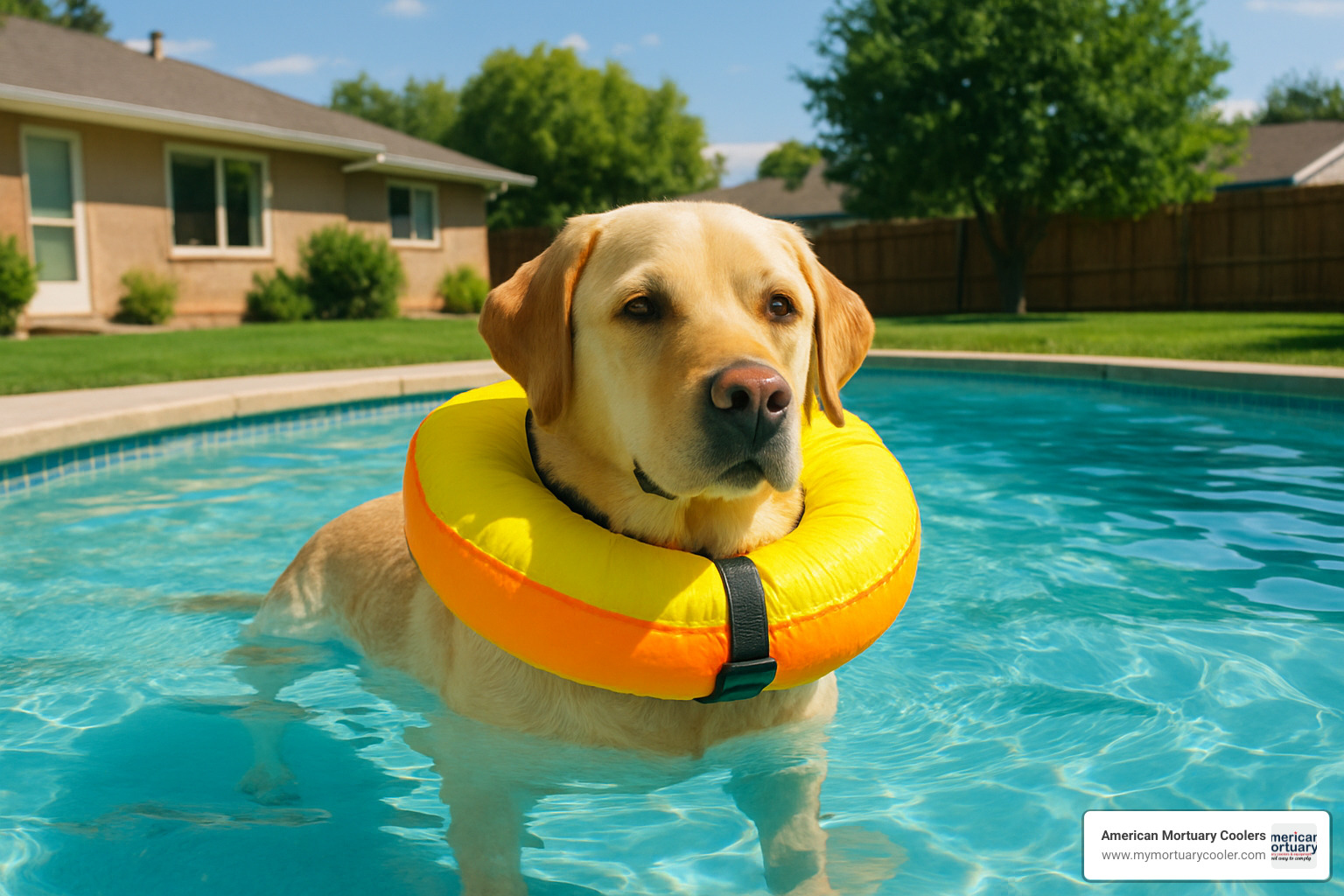
The design balances safety with comfort – pets quickly adjust to wearing them, often forgetting they have them on altogether. While no flotation device replaces attentive supervision, these collars provide that crucial extra layer of protection when seconds count.
Therapy & Infant Neck Rings
When it comes to water therapy and helping little ones develop their motor skills, flotation collars play a gentle yet crucial role. These specialized neck rings provide just the right amount of support for babies during their first aquatic experiences, creating a safe environment for them to kick, splash, and build confidence in the water.
Flotation collars designed for therapy and infant use feature thoughtful details that prioritize comfort and safety. The best models use soft PVC inner rings that rest gently against delicate skin without causing irritation. Parents especially appreciate the dual safety lock systems that provide peace of mind during those precious water moments.
Whether you're a physical therapist working with patients or a parent introducing your baby to swimming, you'll find these collars available in four different sizes—from Small to Extra Large—to accommodate growing children and different therapy needs. Most are reasonably priced between $45 and $50, making them an accessible option for many families.
Aquatic therapists often recommend these supportive devices because they allow for a greater range of motion while maintaining proper head position. For infants, this freedom of movement in water helps develop core strength and coordination in a low-impact environment.
Top Pick: WaterWay Babies Neck Ring
The WaterWay Babies Neck Ring, available through Theraquatics, stands out as a favorite among parents and therapists alike. Its thoughtfully designed soft PVC construction feels comfortable against a baby's skin, while the dual safety locks provide that extra reassurance that the collar will stay securely in place.
What makes this particular model special is how it balances support with freedom. Babies can experience the sensation of floating independently while parents maintain complete control of the situation. Of course, it's worth emphasizing that adult supervision is absolutely essential at all times when using any infant flotation device—these collars are aids, not substitutes for watchful care.
Many parents report that their little ones seem to genuinely enjoy their time in the water with these supportive rings, kicking and moving with delight once they adjust to the new sensation of floating.

For therapeutic applications with older children or adults, these specialized flotation collars provide just enough buoyancy to facilitate rehabilitation exercises while allowing therapists to work closely with patients in the water. The gentle support helps reduce anxiety for those recovering from injuries or working through physical challenges.
When selecting a therapy or infant neck ring, look for medical-grade materials and smooth edges to prevent any skin irritation during extended use. The best models strike that perfect balance between comfort and function—supportive enough to instill confidence, yet allowing natural movement for development or rehabilitation.
Maintenance, Standards & Pricing Overview
Keeping your flotation collar in top shape isn’t complicated, but it does take a little care—and trust us, a few minutes’ attention can mean years of extra reliable use.
After each trip, give your collar a good rinse, especially if you’ve been in saltwater or a chlorinated pool. Salt and chemicals can wear down even the toughest materials over time. Once you’ve rinsed it off, dry the collar thoroughly before packing it away. A dry collar is a long-lasting collar—plus, nobody likes that musty smell of mildew!
When it comes to storage, UV rays are the enemy. Sunlight can break down and fade the fabrics and foams, so store your flotation collar in a cool, shaded spot whenever possible. Before each use, take a quick look over your gear: check for cracks in the foam, any leaks, or worn straps and fastenings. For inflatable models, test the valves and make sure they’re sealing tight. If you spot any damage or a tired-looking valve, it’s time for a replacement—don’t wait until you’re up the creek to find out!
Pricing for flotation collars varies by use and build. Infant and pet collars are usually the most affordable, in the $45–$62 range. If you’re outfitting a rescue team or industrial operation, expect to invest more—rescue and industrial collars typically run from $300 up to $700 or more, depending on size and strength. Custom marine and RIB collars can range widely in price because they’re custom for your specific boat and needs, but the peace of mind is worth every penny.
Don’t forget about certifications—they matter, especially for professional or commercial use. Look for the SOLAS mark (for maritime rescue), CE (European safety standard), or ISO 12402 (for international life-saving devices) stamped on your flotation collar. These certifications show the product has been tested for safety and quality.
For more tips on keeping all your safety gear in shape, check out our guide: Essential Equipment for Chicago Mortuaries.
A little routine attention will keep your flotation collar ready for action—whether you’re rescuing, boating, or just making sure your labrador enjoys a safe swim.
Frequently Asked Questions about Flotation Collars
How much extra buoyancy do I really need?
This is probably the most common question I hear from customers looking at flotation collars for the first time. The simple rule of thumb is to aim for at least 1.5 times the weight of whatever you're trying to keep afloat.
For example, if you're securing a 100-pound rescue stretcher with a patient, you'd want a collar providing at least 150 pounds (or about 70 kg) of buoyancy. For industrial applications like mooring ropes, the industry standard is a minimum of 15 kg of buoyancy per meter—this keeps those heavy hawsers visible and floating safely above propellers.
It's always better to have a bit more buoyancy than you think you'll need. Water conditions can change quickly, and that extra margin of safety could make all the difference.
Can a flotation collar replace a life jacket?
In short—absolutely not. While flotation collars are fantastic tools for specific purposes, they aren't designed to replace personal flotation devices.
A proper life jacket provides critical features that collars don't offer: they're designed to turn an unconscious person face-up, provide full torso support, and include reflective materials and whistles for emergency signaling. Whether you're using a pet collar, a therapy ring, or working with marine equipment, always ensure everyone on board is wearing the appropriate Coast Guard-approved PFD.
Think of flotation collars as specialized tools in your water safety toolkit—not as substitutes for the basics.
What certifications should I look for on marine collars?
When investing in marine-grade flotation collars, certifications aren't just paperwork—they're your assurance that the equipment won't fail when you need it most.
For professional and commercial applications, look for these key certifications:
- SOLAS (Safety of Life at Sea): The gold standard for maritime rescue equipment
- CE marking: Indicates compliance with European safety standards
- ISO 12402: The international benchmark for lifesaving equipment
These certifications mean the collar has undergone rigorous testing for UV resistance, material strength, and performance in various water conditions. While they might add to the price tag, they provide peace of mind that's well worth the investment—especially when lives or valuable equipment are on the line.
At American Mortuary Coolers, we understand the importance of reliable equipment in critical situations, which is why we always recommend properly certified safety gear for any water-related application.
Conclusion
When it comes to water safety, a flotation collar might just be the unsung hero you never knew you needed. From supporting rescue stretchers in swift-water emergencies to stabilizing your family boat, these versatile devices offer peace of mind on and around water.
Throughout this guide, we've explored the remarkable versatility of flotation collars. They've helped recover astronauts from the Pacific, kept beloved pets safe during pool time, supported infants during water therapy, and prevented industrial accidents at busy ports. In each case, these simple yet ingenious devices do what they do best – keep things afloat when it matters most.
The beauty of flotation collars lies in their specialized designs. Whether you need the 30kg buoyancy of a rescue collar, the unsinkable stability of a FAST marine system, or the gentle support of a therapy ring, there's a perfect solution waiting for you. Remember to check certifications like SOLAS or ISO 12402 for professional applications, and always prioritize proper fit and material quality.
At American Mortuary Coolers, we understand the importance of reliability and purpose-built design. Though our primary expertise lies in mortuary equipment, we recognize that safety solutions – whether on land or water – share common values: durability, thoughtful engineering, and attention to detail. That's why we're passionate about connecting people with equipment they can trust, no matter the application.
Water doesn't forgive mistakes, but with the right flotation collar, you gain valuable time and stability when challenges arise. It's not just about having the gear – it's about having the right gear when seconds count.
Ready to explore more safety solutions? More info about our complete safety range
Stay safe, stay prepared, and remember – sometimes the simplest solutions make the biggest difference.
